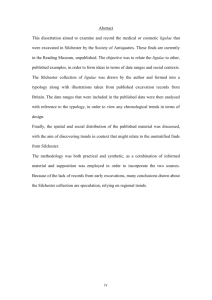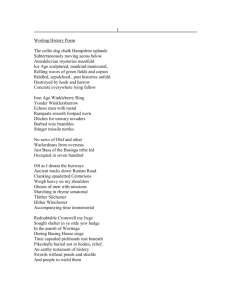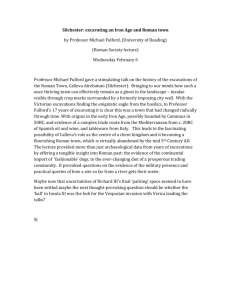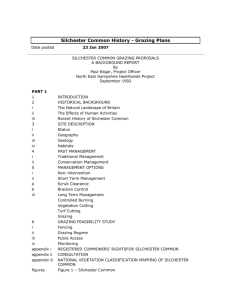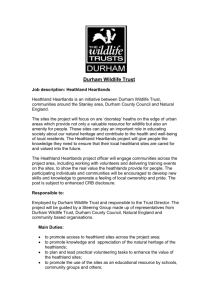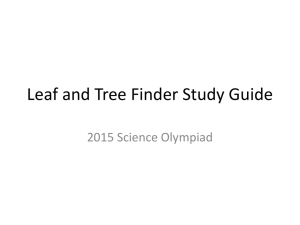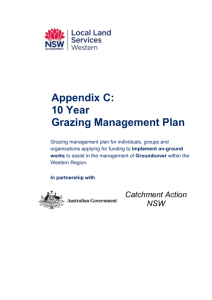Historical Background and Conservation Management
advertisement
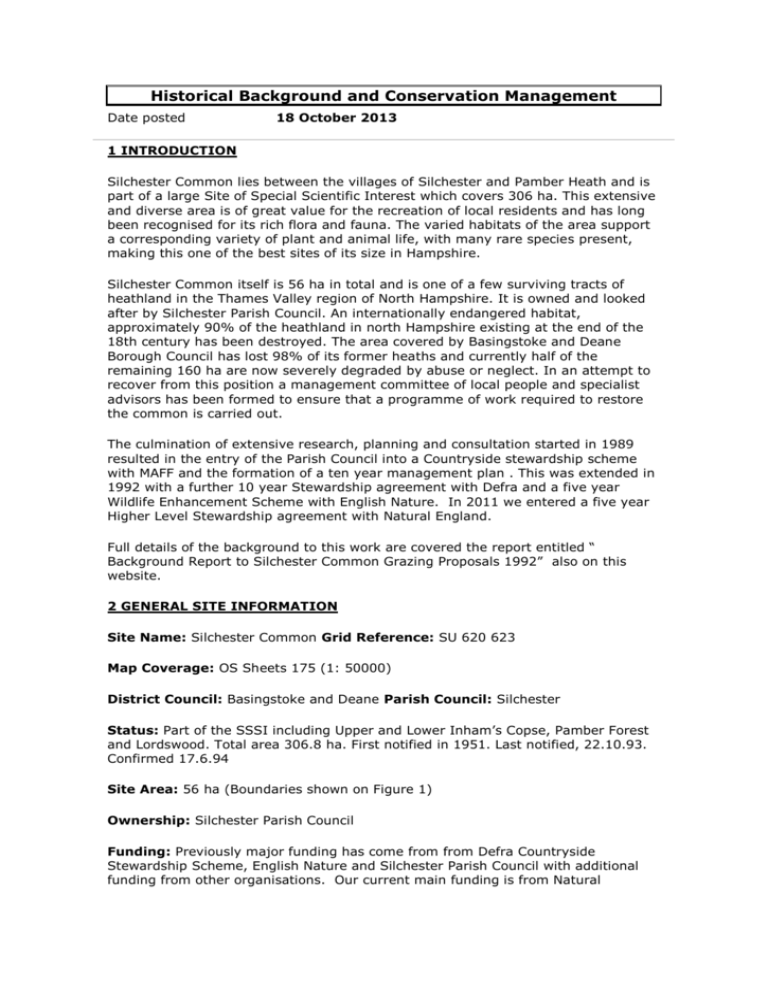
Historical Background and Conservation Management Date posted 18 October 2013 1 INTRODUCTION Silchester Common lies between the villages of Silchester and Pamber Heath and is part of a large Site of Special Scientific Interest which covers 306 ha. This extensive and diverse area is of great value for the recreation of local residents and has long been recognised for its rich flora and fauna. The varied habitats of the area support a corresponding variety of plant and animal life, with many rare species present, making this one of the best sites of its size in Hampshire. Silchester Common itself is 56 ha in total and is one of a few surviving tracts of heathland in the Thames Valley region of North Hampshire. It is owned and looked after by Silchester Parish Council. An internationally endangered habitat, approximately 90% of the heathland in north Hampshire existing at the end of the 18th century has been destroyed. The area covered by Basingstoke and Deane Borough Council has lost 98% of its former heaths and currently half of the remaining 160 ha are now severely degraded by abuse or neglect. In an attempt to recover from this position a management committee of local people and specialist advisors has been formed to ensure that a programme of work required to restore the common is carried out. The culmination of extensive research, planning and consultation started in 1989 resulted in the entry of the Parish Council into a Countryside stewardship scheme with MAFF and the formation of a ten year management plan . This was extended in 1992 with a further 10 year Stewardship agreement with Defra and a five year Wildlife Enhancement Scheme with English Nature. In 2011 we entered a five year Higher Level Stewardship agreement with Natural England. Full details of the background to this work are covered the report entitled “ Background Report to Silchester Common Grazing Proposals 1992” also on this website. 2 GENERAL SITE INFORMATION Site Name: Silchester Common Grid Reference: SU 620 623 Map Coverage: OS Sheets 175 (1: 50000) District Council: Basingstoke and Deane Parish Council: Silchester Status: Part of the SSSI including Upper and Lower Inham’s Copse, Pamber Forest and Lordswood. Total area 306.8 ha. First notified in 1951. Last notified, 22.10.93. Confirmed 17.6.94 Site Area: 56 ha (Boundaries shown on Figure 1) Ownership: Silchester Parish Council Funding: Previously major funding has come from from Defra Countryside Stewardship Scheme, English Nature and Silchester Parish Council with additional funding from other organisations. Our current main funding is from Natural England. 3 SITE DESCRIPTION 3. i. Physical Features 3.i.a. Soils Geologically, Silchester Common lies in the Thames Valley of north Hampshire. Most of the Common lies on an outcrop of Plateau gravel but the lower part off the Common lies on the Lower Bagshot Beds. The Bagshot beds comprise of clays, acidic sands and poor soils and like the plateau gravel provide only limited nutrients. The drainage qualities of these sands and the limiting nutrient availability support an open Birch-Oak woodland community with an understorey dominated by heathland vegetation. Where the clays are exposed drainage is impeded which gives rise to wet heathland and mire communities. 3.i.b. Topography Silchester Common covers 56 ha the highest point of which lies around the 100m contour line. The Bagshot Beds characteristically form a hardpan through a capping of gravel and various other factors. The resulting topography is that of several plateaus varying in size but all with the ground falling away sharply, especially on southern slopes. 3.i.c. Hydrology There are three mires on Silchester common that drain into two streams that run southwards to join Silchester Brook below Lords Wood. The topography and geology are such that the plateaus of the north part of the site are fast draining into the streams below them. The southern end of the site, from Lords Wood to Silchester Road, is very wet underfoot. This is due to a combination of the drainage north of this area and the higher clay content observed in this part of the site. 3.ii. Biological Features 3.ii.a. Habitats Silchester Common is dominated by a variety of heathland habitats which cover most of the 56 ha. The remainder comprises of alder carr, mire and a border of open woodland and scrub. The heathland area is one of the best examples of the full transition from dry to wet heathland habitats around the Hampshire-Berkshire border. It is also one of the last few remaining remnants.. The northern part of the Common is dominated by birch and Common gorse scrub, which gives way to dry heathland which makes up the majority of the common. The dry heath graduates into humid then wet heath towards the streams. In the middle of the site, adjacent to the narrowing at the south end of Lords wood, birch and common gorse again predominate and the southern narrow strip of the site is dominated by oak woodland. A complete National Vegetation Classification (NVC) survey was carried out in 1992 and little has changed since this survey was carried out, with the exception of the birch encroachment in the north and other smaller areas of Sallow scrub. The heathland communities on the common are excellent examples of their kind and recent management has preserved their value for conservation. 3.ii.b. Plant Species The wide range of habitat types found on Silchester Common is reflected in the high number of plant species found there. Of the heathland habitats in northeast Hampshire over 30% of the true heathland plant species are to some degree categorised as rare. This proportion of rarities is also reflected in the animal groups, which makes heaths such as Silchester Common a high priority for conservation management. Information from the NVC survey and other records indicates that the Common supports over 320 species of higher plant, 29 bryophytes and 75 fungi. 3.ii.c. Animal Species The diversity of habitats is also reflected in the fauna found on Silchester Common. There is a very diverse Aranae and insect fauna. Hymenoptera are well represented including a nationally scarce solitary wasp which thrives on the bare ground found in heathland habitats. Lepidoptera are well documented and there are over 200 species listed for Silchester Common alone. There is an extensive list of over 100 bird species recorded on or near the common which includes several Nationally Scarce Species and three Red Data Book species associated with heathland; Caprimulgus europaeus, Nightjar, Lullua arborea, Woodlark, Sylvia undata, Dartford Warbler. Refer to the list at the end of this report. The other significant vertebrate fauna are the reptiles. Four of the six native species are found on the Common, which provides the ideal habitat for them. They are Lacerta vivipara, Common Lizard, Anguis fragilis, Slow worm, Natrix natrix, Grass snake and Vipera berus, Adder. Of the larger vertebrates Oryctolagus cuniculus, rabbit, Vulpes vulpes, fox and Capreolus capreolus, Roe deer are present. 3.iii. Cultural Features 3.iii.a. Common land status Silchester Common has common land status and The rights of the Common are registered under the Commons Registration Act, 1965, for 29 properties on or beside the Common. The majority of these rights are for grazing but they also include Estovers, Turbary and Gravel extraction. However, the previous lack of interest and practice is part of the reason for the initial decline of the common. Gravel extraction and the digging of peat (Turbary) created ponds and wet areas whilst grazing controlled the dominant and invasive plant species, thus the habitat diversity of the common was maintained. 3.iii.b. Public Access and Use There are only two official Rights of Way through Silchester Common, a bridleway and a footpath, however there is easy public access from a boundary path and other points around the site. A survey of local residents commissioned in 1992 showed that the establishment of a fence in accordance with grazing proposals provided adequate access. 3.iii.c. Past Management During the 1980’s until 1990 scrub clearance was regularly carried out by volunteer groups and the Manpower Services Commission. This combined with uncontrolled heath fires helped to maintain open heath. However, in the long term fires have served to encourage birch and bracken invasion. Since 1992 scrub clearance, stump treatment and bracken spraying have been carried out by contractors according to the previous management plan. A three year consultation process was begun in the early 1990’s and the Common was fenced and a grazing regime introduced in February 1995. Woodland thinning, boardwalk construction and scrub clearance have also been organised by Silchester Parish Council. 4 MANAGEMENT OBJECTIVES 4.i. Short-term Management 4.i.a. Rationale Although scrub clearance and uncontrolled fires have kept much of Silchester Common open, invasion by scrub species is still a major issue. Birch is the main problem which as a pioneer species has a very effective seed dispersal mechanism and can readily produce thick scrub in the absence of natural check such as grazing. The worst of the scrub is in the north of the site resulting from severe fire damage in earlier years. Fires exacerbate the problem as burnt sites are ideal for birch and bracken invasion. Invasion of open areas like heathland by scrub species such as birch, gorse and sallow is part of the natural process of succession. This process also acts on a smaller scale in the wetland areas where purple moor-grass accumulates in large tussocks that smother the wet areas and eventually dry them out. The cattle have proved beneficial in relation to the purple moor grass by breaking it down with their hooves as they graze the area. The task of bringing the succession process under control on Silchester Common is an ongoing one. To maintain a rolling mosaic of different habitats is a continuous process and the grazing regime is part of the scrub control process. 4.i.b. Scrub Clearance The majority of scrub to be cleared from Silchester Common is birch. Unfortunately birch coppices readily and therefore stump treatment is required to prevent regrowth. Where the cleared birch trees are very small the herbicide treatment is carried out in the following summer by application to the leaves. Treatment of stumps of leaves adds to the clearance costs, but these methods have proved very effective. Whilst controlling the birch scrub is the main priority on the Common it is important to remember that birch is of great value for invertebrate fauna and therefore it is desirable to retain some on the Common. There are many insectivorous bird species that feed in birch as well as predatory insects. Birch is the third best species in terms of the number of invertebrate species it supports and open heathland is a situation that appears to benefits many of them. Mature birch trees provide habitat for various species of Fungi and make attractive landscape features but it is important to retain a diversity of ages to benefit the widest group of associated species. Sallow is another species that needs to be controlled especially in the mires and wet areas. 4.i.c. Bracken Control Bracken invasion has become a widespread problem right across the country in recent decades. The problem is exacerbated on areas such as heathlands where uncontrolled fires are common. In the absence of management it forms dense stands which not only shade out other species but secrete toxic root exudates which other species cannot tolerate. Bracken also forms a dense litter layer which smothers other plant species and hence reduces floral diversity. Large bracken stands also present a public health issue, the spores can be a problem for those suffering from asthma. As with birch, however, bracken does have a wildlife value. It provides excellent cover and on heathlands this is often used by snakes and lizards although heather is just as good and a more appropriate species for the heathland community. There are over 40 insect species that are able to feed on Bracken despite it’s toxic nature e.g. the larvae of the Brown Silver-line Moth, Petrophora chlorosata, which has been recorded on Silchester Common. The greatest wildlife value of bracken is in woodland and sheltered glades and therefore bracken control should be concentrated on the areas of heathland whilst part of the stands in the south of the Common are retained. Currently, European legislation is being debated regarding the continuing use of Asulox, the herbicide treatment used for bracken. 4.i.d. Gorse Restoration Gorse is widespread across Silchester Common and much of it is young and healthy, however there are a few stands where it is becoming over mature to the point of being degenerate. At this stage the plant becomes leggy and comprises mostly of a woody stem with little foliage. Gorse is of great value to many species for food and shelter and so it is of benefit to bring most of the gorse stands under management to prevent them reaching the degenerate stage and losing value for wildlife. Effective management is easy and can be incorporated in to general scrub control but without stump treatment. In degenerate stands not all cut stumps will regrow because of their age but those that do will be rejuvenated. Some degenerate bushes should be left to enhance structural diversity providing they do not constitute a fire risk. A rolling programme of gorse clearance results in a mosaic of gorse of different stages and heights which are beneficial to a variety of bird species. Dwarf Gorse, Ulex minor, is also present much of the Common but does not require management. 4.i.e. Restoration of Ponds and Wet Areas The flora and fauna of heathland ponds, as with most, benefit from plenty of sunlight, however, most of the ponds on the common were surrounded by dense scrub. The removal of this scrub will greatly improve the conditions in the ponds by reducing leaf fall into the pond and reducing the shade cast on the water. Again it is important to retain structural diversity, so a small amount of vegetation can be retained on the northern edges of ponds. Tall and emergent vegetation is valuable for emerging Dragonflies and Damselflies which in turn provide a food source for birds. Another problem in the ponds and wet areas on the Common is the development of large tussocks of Purple moor-grass, Molinia caerulea. These smother and dry out the ground and need to be grazed or removed manually. Sallow encroachment is another problem in wet areas and one that needs careful treatment. Non-native aquatic species can be particularly aggressive and have a devastating effect on aquatic communities. It is important to maintain vigilance to prevent the establishment of plants such as New Zealand swamp stonecrop or the introduction of fish. 4.ii. Long-term Management 4.ii.a. Rationale As with any managed site it is important to have a long-term management regime to preserve and enhance the quality of habitat achieved by restoration work. The long term regime should be one of maintenance rather than any repetition of costly initial tasks. Such a regime should have three main objectives: To create maximum habitat diversity, thereby ensuring that the full range of species can survive, with specific management targeted at particular rarities as required. To keep nutrient levels in the ecosystem low, which is essential for the continued vigour and survival of the heathland plant communities. To prevent the succession of scrub and Bracken and the subsequent loss of open heathland habitats and their wildlife. These three objectives are usually compatible with each other but as with any long term management it is important to monitor the effect of such management techniques to avoid over use and potential damage to any part of the heathland community. The most commonly used management techniques are considered below. 4.ii.b. Gorse Management Common gorse is widespread on Silchester Common and is present in stands of varying ages due to previous management and uncontrolled fires. This provides wide structural diversity in the stands but mature gorse bushes provide the best combination of food and shelter and are particularly important for Dartford Warblers during the winter. Coppicing on a 12-15 year rotation is the best way to maintain good quality mature gorse stands. It is best carried out at the end of the winter with all the debris removed. The coppicing regime should aim to maintain a minimum of 50% of the gorse on the site as mature bushes in any one year. However, the impact of uncontrolled fires must be taken into consideration as they will have the same effect as coppicing. It may also be necessary to stump treat some gorse along the paths to help prevent the spread of a fire and keep paths open. 4.ii.c. Grazing Following a three year consultation process, Silchester Common was fenced in the winter of 1994/95 and grazing by a mixed herd of 25 cattle began in February 1995. In the following years the grazing stock has changed including New Forest Ponies, Dexter Cross cattle and Highland cattle. Annual surveys were carried out in the early years of the grazing to assess the impact of the grazing regime on the flora of the Common. A number of exclosures were erected in different plant communities across the common and surveys of the flora within six of them and adjacent to them were carried out. The resulting reports have highlighted benefits and disadvantages which point to a continuation of the grazing regime but with some changes. Behavioural observations of the cattle and ponies on the site revealed that the ponies tended to spend most of their time in the wooded and improved areas whilst the Highland cattle tended to stay in the wet areas. Cattle were observed to browse on all three kinds of heather on the Common with a tendency to concentrate on the young growth on the plant tips. This will encourage further new growth and will be of benefit to the Silver-studded butterfly, Plebejus argus, which relies on it as a food source as a caterpillar. Some trampling damage occurred to the woody stems of the mature Calluna plants but this too has it’s benefits by creating small patches of bare ground which are used by a wide group of species. Invertebrates utilise bare ground for basking, hunting, burrowing and mating whilst reptiles and ground nesting birds also benefit aswell as pioneer plant species. The preferred grazing areas of the Highland cattle were the wet mire areas which has both advantages and disadvantages. Trampling and grazing in these areas has broken down the Purple moor-grass tussocks that were smothering the mires and drying them out. However this is a species that needs control not eradication as the tussocks it produces provide important hibernation sites for reptiles and invertebrates. Another disadvantage of the reduction in Purple moor-grass is ability of tree saplings to germinate in the newly created open ground. The cattle do eat some of the seedlings but there are so many that it is impossible for the problem to be kept under control by the present stock numbers. Increasing the numbers of livestock alone is not a viable option as trampling damage is already adversely affecting the Sphagnum in the mires and overgrazing is also a problem for some species. The most notable example of this is Bog asphodel ,Narthecium ossifragum, which has had a marked decline. Generally the presence of livestock on the Common is having a beneficial effect. Grazing is removing large amounts of combustible material and the presence of livestock may act as a deterrent to those thinking of starting a fire. The movement of livestock around the site is creating new micro habitats as discussed earlier and the diversity of age and structure in the heathland areas is increasing . Since 2001 pure bred Dexter cattle have grazed the Common. These small, hardy animals are well suited to year round grazing without the need to remove them from the Common. Their small size reduces the damage to the wet bog areas and they have less of tendency towards these areas, regularly grazing across the whole of the fenced-in area.. In addition, the use of a separately fenced meadow, part of Pamber Forest Nature Reserve, permits summer grazing which, in turn, reduces the pressure from grazing on summer flowering species. APPENDIX Records of Bird Species found on Silchester Common Table 1 89 species recorded on Silchester Common Specific Name Anas crecca Anas platyrhnchos Gallinula chloropus Fulica atra Accipiter gentilis Accipiter nisus Buteo buteo Falco tinnunculus Falco subuteo Circus cyaneus Falco peregrinus Alectoris rufa Perdix perdix Phasianus colchicus Vanellus vanellus Gallinago gallinago Limosa limosa Common Name Teal Mallard Moorhen Coot Goshawk Sparrowhawk Common Buzzard Kestrel Hobby Hen Harrier Peregrine Falcon Red Legged Partridge Grey Partridge Pheasant Lapwing Snipe Black Tailed Godwit Scolapax rusticola Tringa ochropus Actitis hypoleucos Columba oenas Columba palumbas Streptopelia decaocto Streptopelia turtur Cuculus canorus Tyto alba Strix aluco Caprimulgus europaeus Apus apus Picus viridis Dendrocopus major Dendrocopos minor Lullula arborea Alauda arvensis Turdus merula Turdus pilaris Turdus philomelos Turdus iliacus Turdus viscivorus Sylvia communis Sylvia borin Sylvia undata Sylvia atricapilla Hirundo rustica Delichon urbica Anthus trivialis Anthus pratensis Motacilla alba Motacilla cinerea Troglodytes troglodytes Prunella modularis Erithacus rubecula Luscinia megarhynchos Saxicola rubetra Saxicola torquata Oenanthe oenanthe Sitta europaea Certhia brachydactyla Garrulus glandarius Pica pica Corvus monedula Corvus frugilegus Corvus corone Sturnus vulgaris Passer domesticus Fringilla coelebs Phylloscopus sibilatrix Phylloscopus collybita Woodcock Green Sandpiper Common Sandpiper Stock Dove Wood Pigeon Collared Dove Turtle Dove Cuckoo Barn Owl Tawny Owl Night Jar Swift Green Woodpecker Greater Spotted Woodpecker Lesser Spotted Woodpecker Woodlark Skylark Blackbird Fieldfare Songthrush Redwing Mistlethrush Whitethroat Garden Warbler Dartford Warbler Blackcap Swallow House Martin Tree Pipit Meadow Pipit Pied Wagtail Grey wagtail Wren Hedge Sparrow Robin Nightingale Whinchat Stonechat Wheatear Nuthatch Tree Creeper Jay Magpie Jackdaw Rook Carrion Crow Starling House Sparrow Chaffinch Wood Warbler Chiffchaff Phylloscopus trochilus Regulus regulus Muscicapa striata Aegithalos caudatus Parus palustris Parus ater Parus montanus Parus caeruleus Parus major Carduelis carduelis Carduelis spinus Carduelis cannabina Carduelis chloris Acanthis flammea Loxia curvirostra Pyrrhula pyrrhula Emberiza citrinella Emberiza schoeniclus Miliaria calndra Jynx torqullia Willow Warbler Goldcrest Spotted fly catcher Longtailed Tit Marsh Tit Coal Tit Willow Tit Blue Tit Great Tit Goldfinch Sisken Linnet Green Finch Redpoll Crossbill Bullfinch Yellowhammer Reed Bunting Corn Bunting Wryneck Table 2 12 Species recorded overflying Silchester Common Specific Name Larus ridibudus Larus marinus Larus fuscus Larus argentatus Larus canus Phalacrocorax carbo Ardea cinerea Numenius arquata Numenius phaeopus Pandion haliaetus Cygnus olor Branta canadensis Common Name Black Headed Gull Great Black Back Gull Lesser Black Back Gull Herring Gull Common Gull Cormorant Grey Heron Curlew Whimbrel Osprey Mute Swan Canada Goose Table 3 24 Species recorded close to Silchester Common Specific Name Aythya fuligula Tringa totanus Sylvia corruca Falco columbarius Athene noctua Riparia riparia Pluvialis apricaria Alcedo atthis Anthus campestris Lymnocryptes minimus Common Name Tufted Duck Redshank Lesser Whitethroat Merlin Little Owl Sand Martin Golden Plover Kingfisher Tawny Pipit Jacksnipe Upupa epops Motacilla flava Anthus spinoletta Locustella naevia Passer montanus Coccothraustes coccothraustes Lanius excubitor Ficedula hypoleuca Egretta garzetta Acanthis flavirostris Lanius collurio Phoenicurus phoenicurus Phoenicurus ochruros Acrocephalus schoenobaenus Hoopoe Yellow Wagtail Water pipit Grasshopper Warbler Tree Sparrow Hawfinch Great Grey Shrike Pied Flycatcher Little Eagret Twite Red Backed Shrike Common Redstart Black Redstart Sedge Warbler
